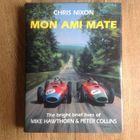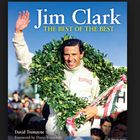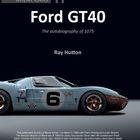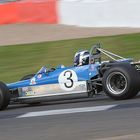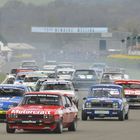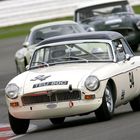Chris Amon: An Appreciation of a Racing Great
- 3 Aug 2016
Share this Article
Formula One racer Chris Amon died aged 73 this morning in hospital in Rotorua, New Zealand, having lost his final battle with cancer. A works Ferrari racer for three seasons, Amon was racing in a period of great change for the sport, staring his career in a 1950s Maserati and racing through to the slicks and wings era of the 1970s. A popular and gifted racer, he was best known for never having won a Grand Prix, though he took victory in non-championship races and major sportscar events.
Amon was the youngest of the three Formula One stars to come out of New Zealand in the 1960s, and was described by Sir Jackie Stewart as ‘one of the most skilful and natural drivers to grace Formula One’. Undoubtedly a great talent behind the wheel, his luck seldom matched his ability and he never won a Grand Prix, either through misfortune in a race or a tendency to be in a team in one of their poorer seasons. As another contempory racer joked: “If Chris Amon quit racing and became an undertaker, people would stop dying”.
At just 17-years-old Amon was racing a Maserati 250F in events in New Zealand, and having caught the eye of team owner Reg Parnell found himself on a plane to the UK in early 1963 and going straight from Heathrow airport for a seat fitting in a Lola T4 in Parnell’s workshops.
“This was the first current Formula One car I had seen,’ said Amon in Eoin Young’s excellent book Forza Amon, “and I was sitting in it and getting measured for it.”
His first race was a non-championship outing at Goodwood, when he took fifth in a 100-mile race, though the field of Formula One cars was described as ‘not the biggest’. His Grand Prix debut was delayed when the team replaced him, reportedly after a financial incentive from race organisers, with French favourite Maurice Trintignant at the Monaco Grand Prix.
That meant his first race was the 1963 Belgian Grand Prix at Spa, where he retired the 1500cc Lola with an oil leak on lap ten. Two seventh place finished were the highlight of that first season, with a second year with Parnell yielding a fourth place finish at Monaco.
1965 was spent mostly racing sportscars, and a move to McLaren for 1966 never came to fruition – though he did take victory in the Le Mans 24-Hours sharing a Ford MkII with Bruce McLaren.
Things looked up for 1967 when he signed with Ferrari and immediately tasted success, winning the Daytona 24-Hours in a 330 P4 shared with Lorenzo Bandini, and also winning the Monza 1000km. His first Formula One outing did not go to plan when he crashed his road car one the way to Brands Hatch for the non-championship Race of Champions – but was third at Monaco in his GP debut in a V12 312/67, a race that saw team-mate Bandini killed.
Amon was soon under pressure as the effective Formula One team leader with the loss Bandini, Mike Parkes being injured in the Belgian GP and Ludovico Scarfiotti leaving. He responded with further third place finishes at Silverstone and the Nurburgring, leaving him joint fourth in the drivers’ points at the end of the season.
The next season proved frustrating, Ferrari active in many areas of motorsport at that point, possibly to the detriment of their Formula One ambitions, with fourth in Mexico and a fighting second – having battled with Jo Siffert – at Brands Hatch, highlights of a season that saw seven retirements. “If things had gone the other way for me I could have won the world championship that year,” Amon told Young, “As it turned out, I never even won a race.”
A win the Tasman series at the start of 1969 in Ferrari’s lovely Dino 166 boded well, but a limited Formula One campaign yielded just two finishes, one a podium at Zandvoort, and Amon was starting to look elsewhere to further his career.
He signed for the new March team for 1970, and with Cosworth DFV power in his 701 was second at Spa and also in the French GP at Clermont-Ferrand. Seventh in the points was not enough and he signed with the French Matra outfit for the next two years, starting his tenure with a non-championship win in Argentina.
Amon’s luck continued during his two years in the V12 Matra-Simcas, a third in Spain the highlight of 1971, with the same slot at Clermont-Ferrand the stand out result of that season. In the lead battle at Monza he lost his visor from his crash helmet, while at Clermont-Ferrand in 1972 he was on pole, set fastest lap – only to puncture while leading and take that third place finish.
Matra withdrew form Formula One at the end of 1972, and a move back to March fell apart before the first race, a sixth the sole finish in seven races with Tecno, while a 10th for Tyrrell in Canada was his only outing forthat team.
A decision to run his own team for 1074 racing the Cosworth-powered Amon AF1 proved problematical, the car only qualifying for one race, retiring from the Spanish GP, while two outings for BRM at the season end resulted in just a ninth pace finish at Watkins Glen.
Just when it seemed his career was over Amon drove two races late in 1975 for Mo Nunn’s Ensign team, and in 1976 reminded people what he was capable of with some strong drives the quick but fragile N176. He was fifth at Jarama, but the failures of the Ensign were a worry and he left the team – but an outing for Wolf at the Canadian GP saw him t-boned by another car in practice, and Amon decided his Formula One days were over.
He started 92 Formula One Grand Prix scoring 83 points (in days of a much reduced points tally for a top six finish), but was always spoken of by other drivers as a great talent and racer. He returned to his family farm in New Zealand on his competitive retirement.
Popular Articles
April 2025 Podcast: Eddie Jordan, Much Missed Maverick
March 2025 Podcast: Targa 66, Race Retro, Scalextric and Famed Journo Pete Lyons!
February 2025 Podcast: Brian Redman, the First Daytona 500, the Pick of the Ecclestone Collection and so Much More!
January 2025 Podcast -Indy Collection, Daytona and Baghettii's Debut F1 Win!




